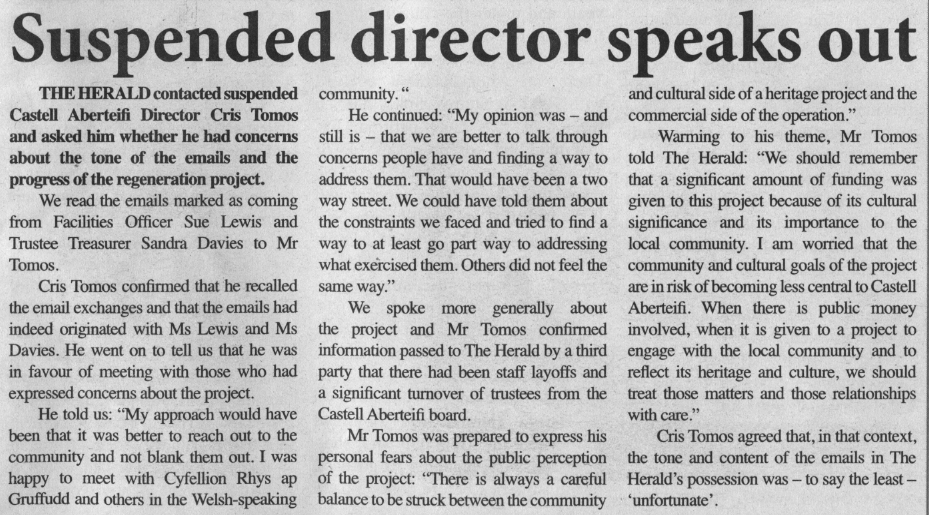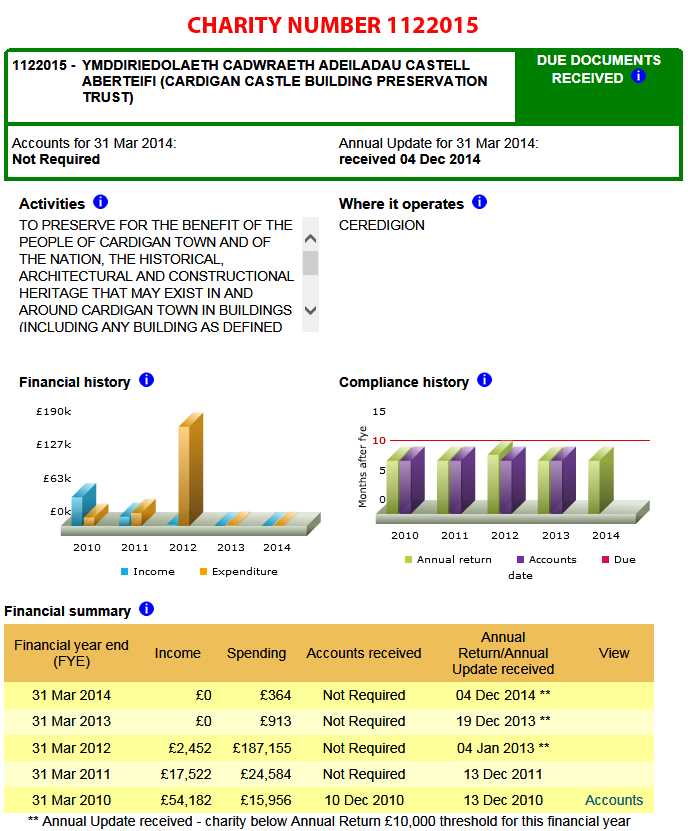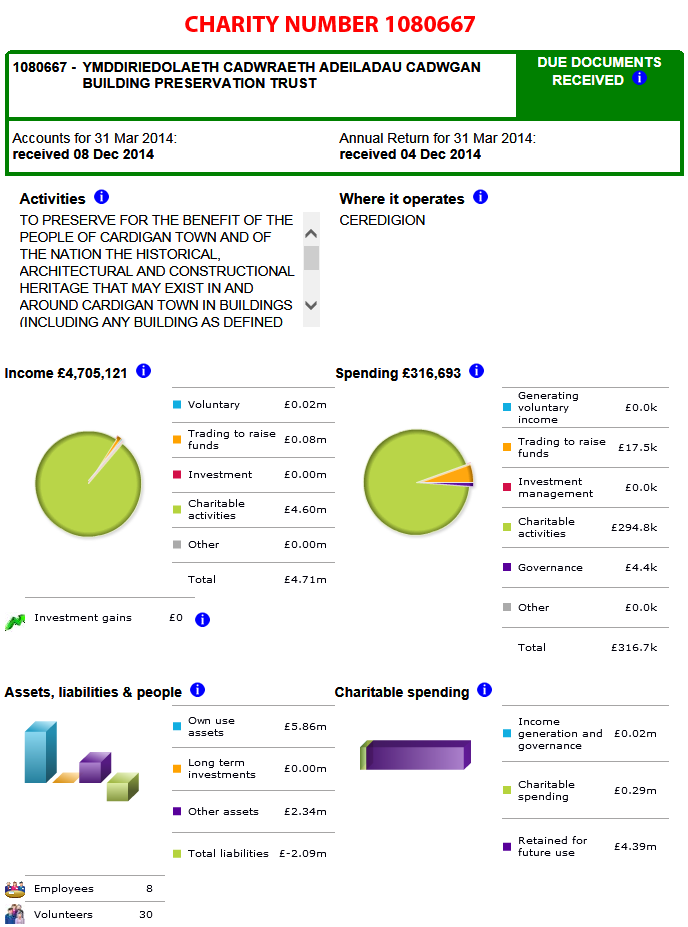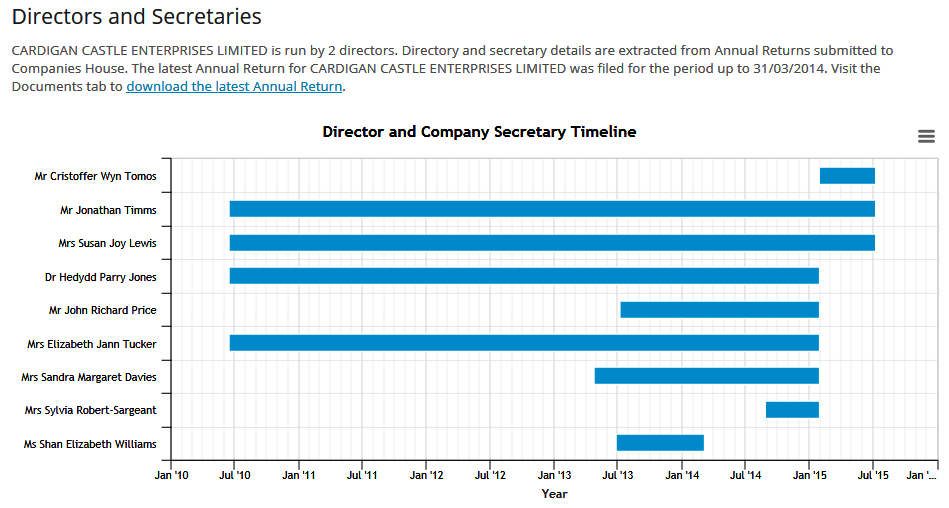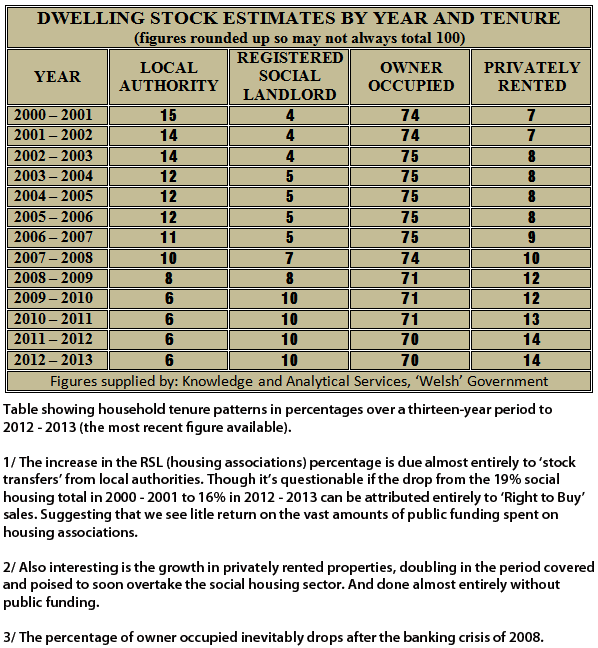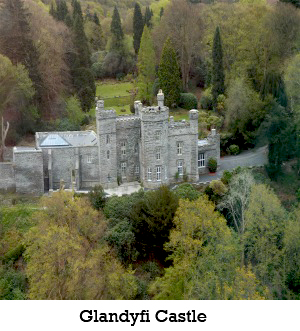My two recent posts on Cardigan Castle have generated an incredible response. On Thursday the 9th – when I was away in Pembrokeshire – my blog received a record 2,223 visits, and the ‘Cardigan Castle – Ready to Fall?’ post has been shared on Facebook an incredible 534 times, another record. Since then, more information has been received, in comments to the blogs, and also in e-mails and DM tweets. To the point where I feel the time has come to lay out the allegations against those who are – allegedly – running this fiasco.
Those familiar with the saga will know that the four principals are Mrs Elizabeth Jann Tucker MBE, Mrs Susan Joy Lewis, Mrs Sandra Margaret Davies and Dr Hedydd Parry Jones. The ‘One’, and the only man, is Jonathan Timms. Between them, these five play various roles in the running of the project. Those roles will be explained below.
To recap: Cardigan Castle is an old pile that changed hands many times over the centuries, and as castles go, in a land that has so many, Cardigan is not one of our great castles. But for the people of the town it’s their castle, and for the rest of the nation it’s important because in 1176, when it was home to Rhys ap Gruffydd (1132 – 1197), it hosted the first ever national eisteddfod.
I would advise everyone to set aside half an hour or so and read my previous posts before starting on this one. They are Cardigan Castle – Ready to Fall? (July 7), and Cardigan Castle – It’s Getting Worse! (July 12).
*
It seems only fitting that we start with the grande dame of this enterprise, Mrs Elizabeth Jann Tucker OBE. She was born in 1935 in Cross Hands, Carmarthenshire, the “only child of a well-to-do family” and was, I’m further informed, educated at an English boarding school. She now lives 7 miles north of Cardigan with her husband Tony in Aberporth, where they run a holiday homes business. She was awarded the OBE last year, as this report from the Tivy-Side Advertiser tells us.
By an example of happenstance such as litter this saga, the newspaper report was almost certainly written by Mrs Susan Joy Lewis who was then the editor of the Tivy-Side Advertiser. I say happenstance because Mrs Lewis also lives in Aberporth. And as if that wasn’t enough happenstance for one paragraph, both are trustees at Cardigan Castle!
Jann Tucker and her husband strike me as the kind of people who like to ‘involve’ themselves. Perhaps because they know best. The Charity Commission website tells us that Mrs Tucker is also a trustee of Aberporth and District youth club, and also Aberporth village hall and recreation ground. Hubby is also a trustee of the latter body, and managed to upset locals with a plan hatched in 2008 to sell off part of the car park. And as might be expected, Jann Tucker also belongs to Aberporth community council, whose meetings Sue Lewis used to attend representing the Tivy-Side Advertiser.
It seems that Jann Tucker and Sue Lewis have been friends and neighbours for some years, and if one comment to my blog is to be believed, mutual back-scratching has been the norm. For according to ‘Wenda of the West’, “apparently back in 2006 ish Jan Tucker stole/claimed a parcel of land from Aberporth Primary School, who was chair of the school governors – Sue Lewis, she did nothing to stop her and Mrs Tucker added a nice piece of land to her estate”.
Jann Tucker joined Joined Ymddiriedolaeth Cadwraeth Adeiladau Cadwgan Building Preservation Trust (hereinafter referred to as ‘Cadwgan’) on 21.03.2000, and Ymddiriedolaeth Cadwraeth Adeiladau Castell Aberteifi Cardigan Castle Building Preservation Trust (hereinafter referred to as ‘Castell’) 28.03.2000. She still serves as trustee on both charities and also served as a trustee / director on Cardigan Castle Enterprises Ltd from 15.06.2010 to 28.01.2015.
*
The next up in our Gang of Four profiles is Mrs Susan Joy Lewis herself. So what do we know? For a start, she was born in Devonshire, England, in 1962. Until late last year she was the editor of the Tivy-Side Advertiser. As we’ve already learnt, she lives in Aberporth, with husband Mike, who is also a journalist.
Sue Lewis served as a trustee on ‘Cadwgan’ from 18.03.2002 until 12.01.2015. (Though she is still shown as a trustee on the woefully out-of-date details to be found on the Charity Commission website.) She probably resigned from this charity to take up the paid post of the Castle’s Facilities Officer, something I shall return to in a minute. Though she still serves as a trustee on ‘Castell’, which she joined 19.12.2007. And she is also a trustee / director of Cardigan Castle Enterprises Ltd, which she joined 16.06.2010. Away from the Castle she is also a trustee / director of Small World Theatre.
I suppose it’s worth asking why there is no Welsh version of ‘Castle Enterprises Ltd’. Perhaps because it wasn’t formed until 2010, and Lewis was on board from the start, as was her neighbour, Tucker. Though that said, and despite its name, it’s a company that doesn’t seem to be that enterprising, with a net worth of £0 and doing hardly any tradi ng. Which only serves to make more corporeal the spectre of yet another project that will forever be suckling on the teat of public funding.
ng. Which only serves to make more corporeal the spectre of yet another project that will forever be suckling on the teat of public funding.
A few lines back I mentioned Sue Lewis becoming Facilities Officer at the Castle early this year . . . very soon in fact after losing her job as editor at the Tivy-Side Advertiser. In the taverns and coffee-houses of Cardigan dispute rages as to how this came about. Essentially, there are two interpretations.
The first – and more charitable version – posits a scenario along these lines. With the Castle opening to the public in 2015 it was felt – in the latter part of 2014 – that a restructuring was needed to meet the fresh challenge. And so existing staff were laid off (but encouraged to re-apply for their jobs). It was simply unfortunate – but unavoidable – that the new post of Facilities Office (salary £25,000 p.a.) was advertised over the Christmas period, and only on the Castle’s Facebook page, which must have been visited by as many as . . . oh, I don’t know, a dozen people.
(UPDATE 25.07.2015: I am indebted to ‘M O’ for providing this link which seems to show that the post of Facilities Officer was first advertised on December 23rd 2014 with a closing date for applications of January 2nd 2015. In other words, from Christmas Eve to New Year’s Day. This is how things are done when the post has already been allocated but the clique involved has to pretend otherwise.
That this was allowed strengthens my belief that what we see at Cardigan Castle is what the funders want – an English tourist attraction and events venue stripped of all Welsh content and significance. Though I’m not sure the funders fully understand that the project they’re supporting may be camouflaging the real estate ambitions of some of those involved, and others close to them.
What is now clear is that Sue Lewis became Cardigan Castle Facilities Manager by deception and nepotism. I would hope that the way this post was advertised and allocated broke both charity law and the rules applied by the funders. But even if it didn’t, Sue Lewis’ position is now untenable. She must go, from her post as Facilities Manager and from all involvement with Castell Aberteifi.)
The second – and less charitable version – portrays a different sequence of events entirely. Having been told in early December that she was about to get the chop Sue Lewis and her friends decided to capitalise on the already announced restructuring and use it to create a new post for her, and then go through the motions of advertising that post over Christmas. She may even have been tipped off about her redundancy before the restructuring was announced.
Proponents of both versions seem to agree on three important points:
1/ The post of Facilities Officer was inadequately advertised, if it was advertised at all.
2/ Sue Lewis was appointed to the post by her friends and neighbours.
3/ She has no experience of the duties she is now expected to fulfil.
The Small World Theatre is a company based in the town that, with its falling income, may see regularly performing at the Castle as its financial salvation. If so, then it was obviously a wise move to get Sue Lewis on board in May, 2012, and it’s already reaping rewards. For as this letter written to a local politician puts it, “It is also worrying to be told that over £15,000 has been given to Small World Theatr for putting on very English based summer activities for children without any opportunity for other Welsh theatre groups to bid for the money and offer more suitable performances. There is a very serious and corrupt edge to this development as Sue Lewis is a trustee of Small World . . . “.
Elin Jones, the Plaid Cymru AM, is a ‘Friend’ on Lewis’ Facebook page.
In fact Plaid Cymru, the party, has behaved in its usual manner when confronted with ‘awkward’ situations – it has slunk away to the shadows for fear of upsetting people. And in the process abandoned a Welsh cause. God! I hope Plaid Cymru is destroyed next May.
*
Next in line is Mrs Sandra Margaret Davies, born 12.06.1949. She is married to Meirion Davies, a teaching assistant some 17 years her junior. Having been born and raised locally she of course speaks Welsh, but like Jann Tucker, chooses not to. Now prepare to overdose on happenstance.
Mr and Mrs Davies live in Aberporth. (Where else!) Sandra Davies is the vice-chair of the governors of Ysgol Gynradd Aberporth. The chair, you will remember, is Sue Lewis! Meirion helps out at the local youth club, where other trustees are Jann and Tony Tucker. I stopped digging at this point because, quite frankly, there’s a limit to how many connections I can take. But I think I’ve established that we have here three people, Jann Tucker, Sue Lewis and Sandra Davies, who are all trustees at Cardigan Castle, who all live in the same small village some 7 miles up the coast, and who all know each other very well, having worked together on other bodies.
We all say, ‘It’s a small world’, but humbling phenomena like this bring home to us how true that is. Oh, yes.
Sandra Davies is now retired but formerly worked at the English military’s weapons establishment in Aberporth which used to provide many jobs for local people, alongside the service personnel and the ex-servicemen (who always had priority for civilian jobs). Nowadays the base employs far fewer locals and is engaged in developing drones, for both military, surveillance and commercial use.
She joined ‘Castell’ 27.11.2013, but seems never to have been a member of ‘Cadwgan’, maybe because, as she claims to be the trustee-accountant or some such, she too is getting paid. She joined the spectacularly unenterprising Cardigan Castle Enterprises Ltd on 24.04.2013.
Though one perplexing chapter in her recent history is Keykeeper Wales Ltd, Company No 08517357. It was in existence from 07.05.2013 to 20.01.2015 but never made any returns or filed any accounts. It seems to have been one of those companies that are set up, do nothing, and then fold; leaving one to think, ‘What the hell was that about?’ Apart from the Davieses the only other directors were William Neil Chambers and Nicola Lesley Chambers.

To help you understand Sandra Davies, and other self-hating Welsh, I’ll recount her answer when it was suggested to have bilingual front-of-house staff at the Castle. “We’ll never get world class staff if we have to rely on the Welsh”. World class staff! How much do they intend paying these ‘world class staff’?
Sandra Davies is also on Facebook.
*
If we pass the Davies residence and keep going up the road we soon come to the village of Tresaith, near to where we find Dr. Hedydd Parry Jones. On the one hand, it’s nice to get away from the stifling incestuousness of Aberporth, but on the other hand, we are of course moving further away from Aberteifi.
get away from the stifling incestuousness of Aberporth, but on the other hand, we are of course moving further away from Aberteifi.
There’s not a lot to report about Dr Jones, she’s another who keeps a low profile. I’m told that before her retirement she was a GP in Castell Newydd Emlyn and is, I’m also told, married to a farmer in the Tresaith area.
She came relatively late to the Gang of Four, joining ‘Cadwgan’ on 18.11.2009, and ‘Castell’ on 25.04.2012. She served her time with Cardigan Castle Enterprises Ltd from 15.06.2010 to 28.01.2015.
One spectacularly offensive remark has been attributed to her. During a discussion on whether the Gorsedd should be invited to the spiritual home of the National Eisteddfod, she is reported to have contributed, “Over my dead body”.

Hedydd Jones is also on Facebook, and despite her being another shrinking violet, I have managed to secure a photograph.
*
It’s almost a merciful relief to be leaving the Ceredigion coast, but I don’t believe we should have to move as far as Kent, in England, for that relief, which is where we find Jonathan Richard Timms. ‘Who’, you cry, ‘is Mr Timms?’
Another figure of mystery is Jonathan ‘Joff’ Timms. We know he was born in 1945, so he’s of a ripe age, and he joined ‘ Cadwgan’ 15.11.2006. On the Charity Commission website he is even listed as the contact for the trust. (Click to enlarge panel on right.) He joined ‘Castell’ 18.04.2007.
Cadwgan’ 15.11.2006. On the Charity Commission website he is even listed as the contact for the trust. (Click to enlarge panel on right.) He joined ‘Castell’ 18.04.2007.
As if that wasn’t enough, he and Sue Lewis seem to be the only directors left standing at Cardigan Castle Enterprises Ltd. So he appears to be the one person who is a trustee for both trusts and is also a trustee / director of the trading arm. So how does that work, with him living so far away? Does he make the 620 mile round trip to attend every meeting, or are meetings arranged for when he might be in the area? Though come to that, why would he be in the area at all? Well, boys and girls, you will not be surprised to learn that a dickie-bird tells me Mr Timms has a holiday home in Aberporth, and that he was almost certainly invited aboard the good ship Cardigan Castle by Jann Tucker.
A regular contributor to my blog, ‘Brychan’, had this to say of Mr Timms:
“The mysterious Mr Timms has moved.
When originally registered at the charity commission he declared he was resident at a period mansion, Glebe House, Mersham in the Weald of Kent. This property is Grade II listed. It was renovated by Talus, who are specialists in restoring period structures and sub dividing the property for sale. Half of this property is now up for sale for £950,000. I find no record of title change for the other parts of the structure. 12 other properties were built on associated land.
Mr Timms subsequently changed his address declared at the charity commission to another of his properties at 44 Oxenturn Road, Wye, a village some miles away, nestled in the North Downs.
It is quite evident, as his original Glebe House period mansion changed from detached to two semi-detached properties, that he specialises in buying and renovating period structures and then sub-dividing them for sale as separate units at vast profit. The ‘wedding venue’ and ‘events’ businesses that habit the property for a short period are merely ghost enterprises, the real cash is generated by the sub-division and subsequent piecemeal sale of a renovated freehold.
Do the good people of Aberteifi really know who they’re dealing with? I have assumed the ‘Welsh’ Government, CADW and Cyngor Ceredigion have done the precautionary background checks on this geezer. I wonder what he did with his bats? Did they move to Wye or Aberteifi?”
So Jonathan Timms appears to be a property specialist whose forte might be converting and flogging period and listed buildings, such as – dare I say it? – Castle Green House inside the Castle grounds. (Click to enlarge image.)
Also note that both trusts, in their declarations to the Charity Commission, state their objectives thus: “To preserve for the benefit of the people of Cardigan town and of the nation the historical, architectural and constructional heritage that may exist in and around Cardigan town in buildings (including any building as defined in Section 336 of the Town and Country Planning Act 1990) of particular beauty or historical, architectural or constructional interest’. Which suggests that certain persons’ ambitions may not be limited to the Castle.
I’m told Mrs Timms was acting as a ‘volunteer’ when Our Glorious Leader visited the Castle last month.
*
This is the situation now, but the problems with Cardigan Castle go back years, to when the renovation was being done. There are too many problems to list them all, but one worth mentioning is the complaint from local businesses that they were not invited to tender for the work being done on the Castle.
Now there could be a simple explanation for this in that the main contractor, Andrew Scott Ltd of Port Talbot, was allowed to choose its sub-contractors and suppliers, perhaps arranging its own tendering processes. But if so, why did those representing the Castle not insist that the process be opened up to local contractors and suppliers?
Alternatively, if handing out the contracts to suppliers was within the gift of the trustees then local anger is understandable, and helps explain why a complaint I’ve heard more than once concerns the work given to Leekes of Cross Hands to supply furniture, fittings, sanitary ware and much else that could have been sourced cheaper locally. Inevitably, seeing as Jann Tucker was born in Cross Hands, people suggest she is related to the Leekes family. Possibly, though another option is that a member of the Leekes clan has a holiday home on the Ceredigion coast – Llangrannog has been mentioned – and is known to the Gang of Four, or some of them, or perhaps just one of them.
One of the most serious complaints I’ve heard is contained in the letter to a local politician I linked to above. (Here’s the link again.) The writer says, “We have at least 60 people in Cardigan who have asked to join (the trust, presumably) but have just been ignored”. This suggests that the Gang of Four doesn’t want anyone involved who isn’t going to toe their line. No elections, no applications; entry is by recommendation and invitation only, a methodology they might have picked up from their Freemason husbands.
Another regular complaint is that there seems to be no constitution for members of the public to consult, which charity law says there should be. Then there’s the issue of minutes being doctored, with the final versions bearing little resemblance to what took place in the meetings the minutes supposedly refer to. And as mentioned in the earlier posts, there is the absurdly high turnover in staff and trustees for the very simple reason that no one can work with the Gang of Four.
One of the more bizarre complaints is that the trustees spent £100,000 on a wedding marquee, a permanent structure but, of course, without foundations. This was done despite being told that weddings can only be in held in a building with three sides and a roof. As I say, this is one of the more bizarre complaints, but if true, then it displays a stupidity, and exposes a waste of public money, that should not go unpunished. Regarding this marquee, Jann Tucker averred that she didn’t want any “local riff-raff” getting married in it.
Sticking with the bizarre, another story I was told by, I suspect, someone who worked on the project, was that the main contractor, Andrew Scott Ltd, was told by a local contractor that the sewage / drainage system was 300mm ‘out’. The advice was ignored and now the Castle is said to have problems with this system. Oh yes, the same source tells me that the Castle has bought two banana trees. I just hope these are traditional Welsh banana trees.
Cardigan Castle is clearly in deep, deep trouble. A £12m project is being run by people who are out of their depth. Incompetence would be bad enough, but they compound that failing by being unpleasant creatures given to venomous, insulting outbursts. Small wonder the townspeople of Aberteifi feel alienated. They see no one from their town involved in running the Castle, and local businesses excluded from the £12m bonanza! Welcome to Aberporth Castle . . . with the contact address in Kent.
*
That the major funders involved, the Heritage Lottery Fund and the ‘Welsh’ Government, have not stepped in to replace these women, and Mr Timms, with a board of trustees operating more transparently, a board more representative of Cardigan and the surrounding area, makes those funders complicit in and responsible for the malpractice now taking place.
Beyond malpractice we also have the clearly expressed sentiments of hostility towards the Welsh language, Welsh culture, and Welsh people. Outbursts that should disqualify these women from involvement in any project in Wales using public funding.
They themselves are the intolerant bigots they accuse their critics of being. Get rid of them!

 rust for pricing the castle’s holiday accommodation at levels which will undermine existing local businesses. At the same time, the wedding venue business is being pitched at well-heeled clientèle from outside the area and priced at levels which will exclude most locals.
rust for pricing the castle’s holiday accommodation at levels which will undermine existing local businesses. At the same time, the wedding venue business is being pitched at well-heeled clientèle from outside the area and priced at levels which will exclude most locals.










